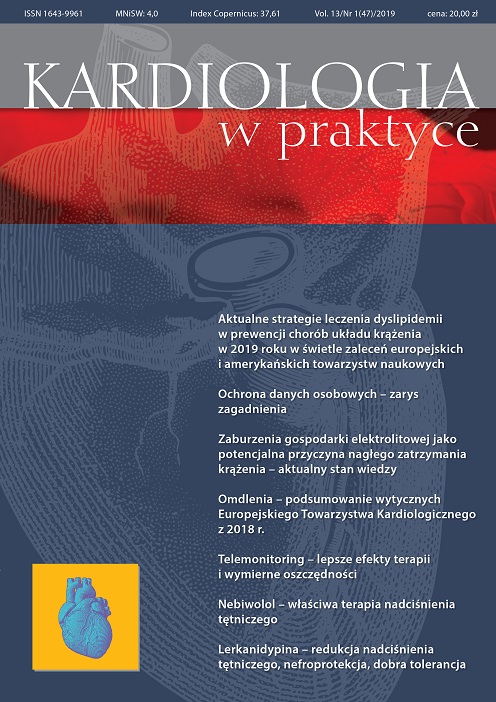Electrolyte disturbances as a potential cause of cardiac arrest – current state of knowledge Review article
Main Article Content
Abstract
According to the current guidelines on cardiopulmonary resuscitation, the reversible causes of cardiac arrest, i.e. one in which specific, effective treatment can be applied, are divided into 2 groups, depending on the first letter of English words, to facilitate their memorization. Both groups consist of 4 elements. These are: 4H group and 4T group. The 4H group includes electrolyte disturbances – for example, hyper-/hypokalemia, hypoxia, hypovolemia and hypothermia. The 4T group includes: thromboembolism, cardiac tamponade, toxins and pneumothorax. Electrolyte serum imbalances are one of the most common problems in clinical practice. They can result in dangerous kinds of arrhythmia,consequently leading to sudden cardiac arrest. Most common causes, EKG morphology abnormalities, possible cardiac rhythm disturbances and recommended treatment are discussed in this paper.
Downloads
Article Details

This work is licensed under a Creative Commons Attribution-NonCommercial 4.0 International License.
Copyright: © Medical Education sp. z o.o. This is an Open Access article distributed under the terms of the Attribution-NonCommercial 4.0 International (CC BY-NC 4.0). License (https://creativecommons.org/licenses/by-nc/4.0/), allowing third parties to copy and redistribute the material in any medium or format and to remix, transform, and build upon the material, provided the original work is properly cited and states its license.
Address reprint requests to: Medical Education, Marcin Kuźma (marcin.kuzma@mededu.pl)
References
2. Franczyk-Skóra B., Gluba-Brzózka A., Wranicz J.K. et al.: Sudden cardiac death in CKD patients. Int. Urol. Nephrol. 2015; 47(6): 971-982.
3. Naksuk N., Hu T., Krittanawong C. et al.: Association of Serum Magnesium on Mortality in Patients Admitted to the Intensive Cardiac Care Unit. Am. J. Med. 2017; 130(2): 229.e5-229.e13.
4. Duval M., Bach K., Masson D. et al.: Is severe hypocalcemia immediately life-threatening? [published online ahead of print, 2018 Aug 28].
5. Gennari F.J.: Disorders of potassium homeostasis. Hypokalemia and hyperkalemia. Crit. Care Clin. 2002; 18(2): 273-288.
6. Niemann J.T., Cairns C.B.: Hyperkalemia and ionized hypocalcemia during cardiac arrest and resuscitation: possible culprits for postcountershock arrhythmias? Ann. Emerg. Med. 1999; 34: 1-7.
7. Montague B.T., Ouellette J.R., Buller G.K.: Retrospective review of the frequency of ECG changes in hyperkalemia. Clin. J. Am. Soc. Nephrol. 2008; 3(2): 324-330.
8. Gross P., Pistrosch F.: Hyperkalaemia: again. Nephrol. Dial. Transplant. 2004; 19(9): 2163-2166.
9. Diercks D.B., Shumaik G.M., Harrigan R.A. et al.: Electrocardiographic manifestations: electrolyte abnormalities. J. Emerg. Med. 2004; 27(2): 153-160.
10. Oline: https://litfl.com/ecg-library/diagnosis/.
11. Zaremba M., Franek E., Rydzewski A.: Hiperkaliemia. Choroby Serca i Naczyń 2006; 3: 36-40.
12. Apel J., Reutrakul S., Baldwin D.: Hipoglycemia in treatment of hiperkaliemia with insulin in patients with end stage renal disease. Clin. Kidney J. 2014; 7: 248-250.
13. Charakterystyka produktu leczniczego (Calcium Resonium) zatwierdzona przez Ministerstwo Zdrowia Rzeczpospolitej Polskiej numer R/3762.
14. Evans K.J., Greenberg A.: Hyperkalemia: a review. J. Intensive Care Med. 2005; 20(5): 272-290.
15. Weisberg L.S.: Management of severe hyperkalemia. Crit. Care Med. 2008; 36(12): 3246-3251.
16. Truhlár A., Deakin C., Soar J. et al.: European Resuscitation Council Guidelines for Resuscitation 2015. Section 4. Cardiac arrest in special circumstances. Resuscitation 2015; 95: 148-201.
17. Franek E., Kokot F.: Hipokaliemia. Choroby Serca i Naczyń 2006; 3: 203-206.
18. Lippi G., Favaloro E.J., Montagnana M., Guidi G.C.: Prevalence of hypokalaemia: the experience of a large academic hospital. Intern. Med. J. 2010; 40(4): 315-316.
19. Weaver W.F., Burchell H.B.: Serum potassium and the electrocardiogram in hypokalemia. Circulation 1960; 21: 505-521.
20. Macdonald J.E., Struthers A.D.: What is the optimal serum potassium level in cardiovascular patients? J. Am. Coll. Cardiol. 2004; 43(2): 155-161.
21. Kim G.H., Han J.S.: Therapeutic approach to hypokalemia. Nephron. 2002; 92(supl. 1): 28-32.
22. Gajewski P., Szczeklik A.: Interna Szczeklika. Podręcznik chorób wewnętrznych. Wyd. 10. Medycyna Praktyczna, Kraków 2018; 12: 2399-2424.
23. Online: http://www.katedraanest.cmuj.krakow.pl/download/downloads/zaburzenia_wodno_elektrolitowe.pdf.
24. Jakubas-Kwiatkowska W., Błachowicz A.: Hipokalcemia w praktyce klinicznej – przyczyny, objawy i leczenie. Choroby Serca i Naczyń 2005; 2: 232-237.
25. Popow M., Bednarczuk T.: Wpływ hipokalcemii na układ sercowo-naczyniowy. Kardiologia Polska 2013; 71(6): 609-610.
26. Brown J., Nunez S., Russel M. et al.: Hypocalcaemic rickets and dilated cardiomyopathy: case reports and review of literature. Pediatr. Cardiol. 2009; 30: 818-823.
27. Wyskida K., Chudek J., Więcek A.: Homeostaza magnezu – nowe aspekty patofizjologiczne w chorobach nerek. Nefrol. Dial. Pol. 2008; 12: 32-33.
28. Rude R.K.: Physiology of magnesium metabolism and the important role of magnesium in potassium deficiency. Am. J. Cardiol. 1989; 63: 31-34.
29. Online: http://ems12lead.com/2014/03/05/magnesium-and-cardiac-action-potential/.
30. Charakterystyka produktu leczniczego (Magnesii sulfurici 20%) zatwierdzona przez Ministerstwo Zdrowia Rzeczpospolitej Polskiej 5.11.2008.

